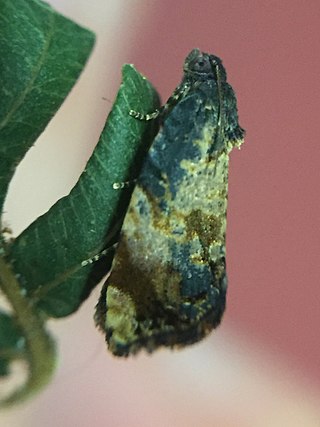
Philocryptica is a monotypic genus of moths belonging to the subfamily Tortricinae of the family Tortricidae. It contains only one species, Philocryptica polypodii, the leather-leaf star-miner, which is endemic to New Zealand. This species has been recorded in both the North Island and the South Island, as far south as Banks Peninsula. The preferred habitat of this species is native forest where the species' larval host is present. The larvae feed on Pyrrosia eleagnifolia, mining the host plant leaves. P. polypodii pupates within the final blotch-mine. Adults are on the wing in November and December.
Apoctena is a genus of moths belonging to family Tortricidae.

Macarostola miniella is a species of moth in the family Gracillariidae. It is endemic to New Zealand. This species is only found in the North Island and the adult moths have two different colour variations.

Izatha prasophyta is a moth of the family Oecophoridae. It is endemic to New Zealand, where it is known from the North Island, except Hawkes Bay or the Wairarapa. Larvae likely feed on rotting wood although larvae of this species have been reared on the fruiting body of the bracket fungus Bjerkandera adusta. Adults are on the wing from November to February.
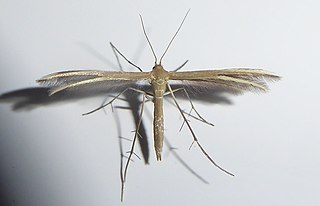
Pterophorus innotatalis is a moth of the family Pterophoridae. It is endemic to New Zealand and has been found in the North, South and Ruapuke Islands. Adults of this species have been recorded as being on the wing from October to March as well as in August and prefers to inhabit grass or fern covered hills. The larvae are leaf miners and feed on Dichondra species, including Dichondra brevifolia and Dichondra repens.
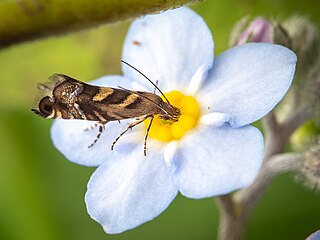
Glyphipterix tungella is a species of sedge moth in the genus Glyphipterix. It is endemic to New Zealand and is found throughout the country. Larvae mine the leaves of small sedges. Adults of this species are day flying and inhabit sheltered scrub or grassy areas and forest clearings.
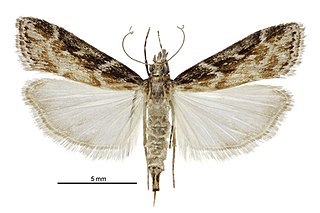
Scoparia molifera, also known as the leather-leaf Scoparia, is a species of moth of the family Crambidae. This species was first described by Edward Meyrick in 1926 and is endemic to New Zealand. It can be found in the North and South Islands. The larvae of this species make silk tunnels from which they mine the leaves of their host, the leather-leaf fern Pyrrosia eleagnifolia. Adult moths are on wing from December to February and are attracted to light.

Apoctena orthocopa, also known as striped ponga leaf-tyer, is a species of moth of the family Tortricidae. It is endemic to New Zealand, where it is found only on the North Island.

Epichorista aspistana is a species of moth of the family Tortricidae. It is endemic to New Zealand and has been collected in Canterbury and Otago. This species inhabits moist grassy areas at altitudes ranging from sea level to 1650m. Larvae feed on species within the genus Acaena. Adults are on the wing in November to February.

Gadira acerella is a moth in the family Crambidae. It was first described by Francis Walker. It is endemic to New Zealand and is found throughout the country. The species inhabits native forest from sea level up to subalpine altitudes. Larvae are assumed to feed on lichen or moss. Adults are on the wing from October until March, are active at night and are attracted to light. This species is distinctively patterned and coloured and is said to resemble a bird dropping at rest. The colouring also assists to camouflage the moth when it rests against lichen.
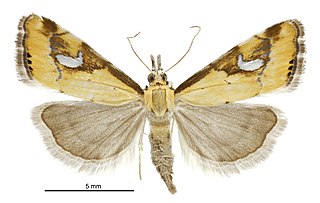
Glaucocharis lepidella is a species of moth in the family Crambidae. It was described by Francis Walker in 1866. It is endemic to New Zealand and is found in both the North and South Island. The species inhabits lowland to subalpine native forest. Larvae may feed on mosses. Adults are on the wing from November to February and are attracted to light.

Glaucocharis interruptus is a moth in the family Crambidae. It was first described by Cajetan von Felder, Rudolf Felder and Alois Friedrich Rogenhofer in 1875. It is endemic to New Zealand.

Pyrgotis eudorana is a species of moth of the family Tortricidae. It is endemic in New Zealand and has been observed in both the North and South Islands. However it is regarded as a rare insect. This species inhabits native forest. Larvae exclusively feed on Muehlenbeckia australis and adults are on the wing from November to April. Adults are attracted to light.
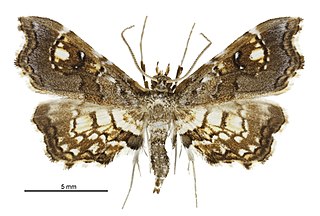
Musotima aduncalis, also known as the maidenhair fairy moth, is a moth in the family Crambidae. It was described by Cajetan Felder, Rudolf Felder and Alois Friedrich Rogenhofer in 1875. This species is endemic to New Zealand.

Eudonia zophochlaena is a moth in the family Crambidae. It was described by Edward Meyrick in 1923. It is endemic to New Zealand. It has been hypothesised that this species is a North Island endemic. The adults of this species are on the wing from December until February. The larvae of this species are leaf miners of the leather-leaf fern Pyrrosia eleagnifolia.
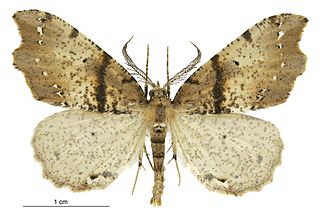
Chalastra pellurgata, also known as the brown fern moth or the pale fern looper, is a moth of the family Geometridae. This species was first described by Francis Walker in 1862. It is endemic to New Zealand and can be found throughout the country. It inhabits native forest. This species is extremely variable both in its larval and adult life stage. Larvae of this species are active during spring and summer. They feed on the fronds of fern species. C. pellurgata pupates by forming a thin cocoon on the soil amongst leaf litter and moss. Adults are on the wing throughout the year but are most common from September to March. During the day adult moths can be observed resting on dead fern fronds. They become active from dusk and are attracted to light.
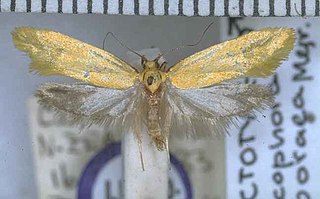
Tingena oporaea is a species of moth in the family Oecophoridae. It is endemic to New Zealand and has been observed in Canterbury. The perferred habitat of this species is native beech forest at altitudes of 2500 ft however it has also been collected in tussock grassland. The larvae of this species are leaf litter feeders and the adults are on the wing in January and February.
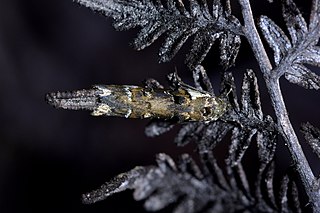
Trachypepla conspicuella is a species of moth in the family Oecophoridae. It is endemic to New Zealand and is found in both the North and South Islands. It is similar in appearance to its close relative T. euryleucota but tends to be paler. Its colouration imitates bird droppings. Larvae feed on leaf litter. Adults of this species are on the wing from November to February and have been observed resting on fences and walls.

Ischalis nelsonaria, also known as the angled fern looper, is a species of moth of the family Geometridae. It was first described in 1875. This species is endemic to New Zealand and has been observed in both the North and South Islands. I. nelsonaria inhabits native forest. The larval host of this species is Zealandia pustulata. Larvae have also been raised on Blechnum novae-zelandiae. Adult moths of this species are variable in appearance and are nocturnal. They have been observed on the wing throughout the year but are most frequently observed in February and March. They have been observed feeding on the flowers of Metrosideros diffusa.
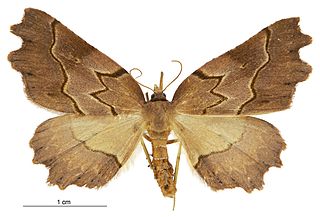
Ischalis fortinata is a species of moth in the family Geometridae. It was first described by Achille Guenée in 1868. This species is endemic to New Zealand and has been observed in both the North, South and Stewart Islands. The species inhabits native forest. The larval hosts of this species include Polystichum vestitum and Polystrichum richardii. Adults have been observed all year around but are most frequently seen from October to February.




















